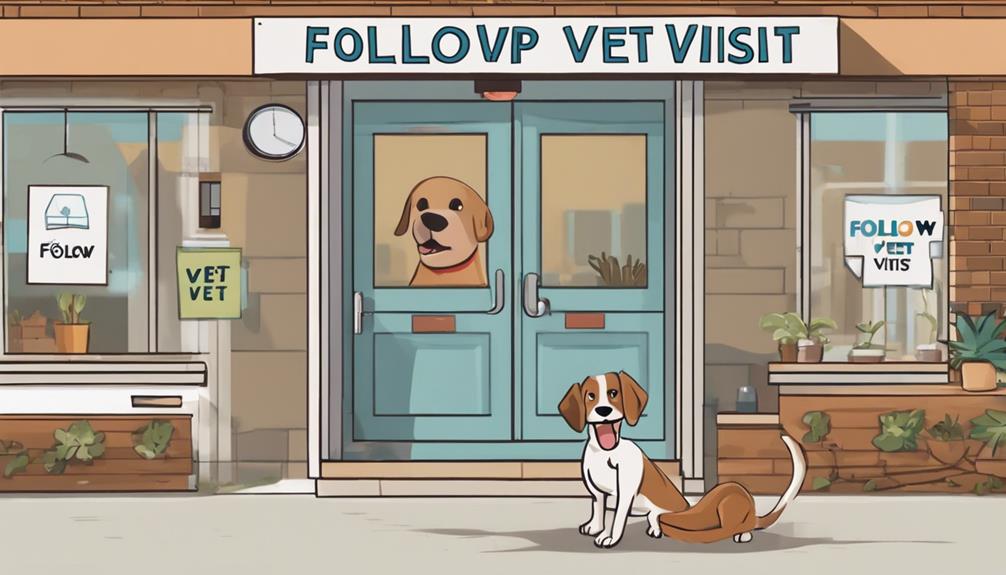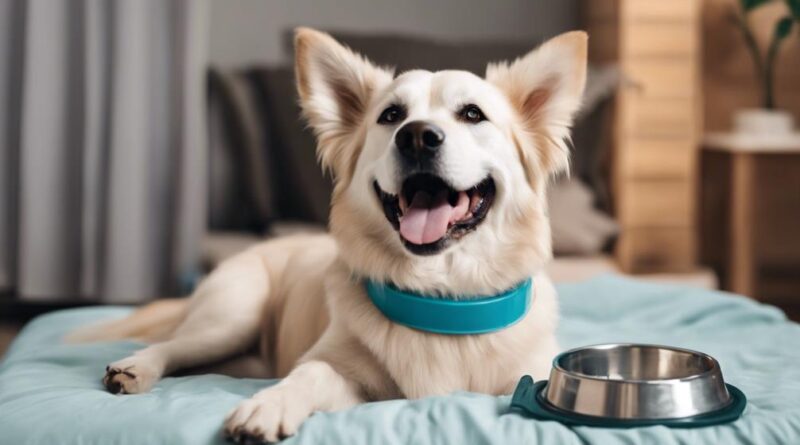Top 10 Tips for Post-Surgery Dog Care
Coincidentally, your furry friend just had surgery, and now you're tasked with ensuring their smooth recovery. From managing medication to creating a conducive home environment, navigating post-surgery dog care can be a challenging yet rewarding experience.
Each step plays a crucial role in your dog's healing process, and by following the top 10 tips, you can provide the best care possible. So, how can you optimize your dog's recovery and support their journey back to health?
Home Environment
When bringing your dog home after surgery, ensure that your home environment is safe and comfortable for their recovery. Create a designated recovery space for your furry friend by setting up a quiet and cozy area where they can rest undisturbed. Make sure this space is free from any hazards that could potentially harm your recovering pup. Keep the area clean and well-ventilated to prevent any infections.
Provide your dog with a comfortable bed or blanket to lie on, away from any drafts or direct sunlight. Ensure that the temperature in the recovery space is suitable for your dog's comfort. Remove any small objects or items that your dog could potentially chew on or swallow. It's crucial to create safe surroundings by securing any loose wires, sharp objects, or toxic substances that could pose a danger to your recovering pet. By taking these precautions, you can help your dog have a smooth and stress-free recovery at home.
Wound Care
To properly care for your dog's wound post-surgery, regularly inspect it for any signs of infection or complications. Proper cleaning and preventing infection are crucial for the healing process.
Here are some essential tips for wound care:
- Keep the Wound Clean: Use a mild, pet-safe cleanser to gently clean the wound and remove any debris or discharge.
- Monitor for Signs of Infection: Watch for redness, swelling, warmth, or pus around the wound, as these could indicate an infection.
- Protect the Wound: Prevent your dog from licking or scratching the wound by using an Elizabethan collar or other protective measures.
- Follow Veterinarian's Instructions: Adhere to the prescribed wound care routine provided by your vet, including changing dressings or applying any recommended ointments.
Medication Management
Inspecting your dog's wound regularly is essential, and now let's discuss the crucial aspect of managing their medication. Pain management is a key component of your dog's recovery process. Ensure you follow the veterinarian's instructions regarding the administration of pain medication. It's vital to maintain a consistent dosing schedule to keep your furry friend comfortable and aid in their healing. Make sure you understand the proper dosage and frequency of the medications prescribed for your dog. If you have any concerns or notice any adverse reactions, contact your vet immediately.
To effectively manage your dog's medication, create a schedule or set reminders to ensure doses aren't missed. Consistency is key in providing your dog with the necessary relief. Store the medications in a safe place, out of reach of your pet and children, to prevent accidental ingestion. Keeping track of when the medication was last given can help prevent double dosing. By staying organized and attentive to your dog's medication needs, you play a crucial role in their post-surgery care.
Rest and Activity
Proper rest and controlled activity levels are crucial for your dog's recovery after surgery. To ensure a smooth healing process, consider the following tips:
- Exercise Restrictions: Follow your vet's guidelines regarding exercise limitations. Restricting strenuous activities can prevent complications during the recovery period.
- Gradual Reintroduction: As your dog starts feeling better, gradually reintroduce light activities. Slowly increasing exercise levels can help prevent setbacks.
- Mental Stimulation: Engage your dog in mentally stimulating activities to keep their mind sharp while physical activity is limited. Puzzle toys or short training sessions can help keep your pup entertained.
- Recovery Timeline: Understand the expected recovery timeline from the surgery. Knowing what to expect can help you plan the rest and activity levels accordingly.
Monitoring Symptoms
Keeping a close eye on your dog's condition is essential for monitoring symptoms post-surgery. Symptom tracking is crucial in detecting any potential issues early on. Watch out for signs of infection such as excessive swelling, redness, or discharge at the surgical site. Additionally, monitor your dog's temperature regularly as a fever could indicate an infection.
Behavioral changes are also important to note. If your dog is unusually lethargic, restless, or displaying changes in appetite or drinking habits, these could be signs of complications. It's vital to observe your dog's breathing patterns; labored breathing or coughing could signify respiratory problems.
Keep a record of any symptoms or changes you notice and promptly inform your veterinarian. By paying close attention to these details and acting promptly, you can ensure your dog recovers smoothly and any issues are addressed promptly.
Nutritional Support
To ensure your dog's optimal recovery post-surgery, providing adequate nutritional support is crucial. A balanced diet plays a significant role in your dog's healing process. Here are some tips to help you ensure your furry friend gets the right nutrition:
- Balanced Diet: Feed your dog a well-rounded diet that includes high-quality proteins, healthy fats, carbohydrates, vitamins, and minerals. This will aid in their overall recovery and promote healing.
- Supplement Options: Consider adding supplements to your dog's diet, such as omega-3 fatty acids or glucosamine. These can help reduce inflammation, support joint health, and boost their immune system during the recovery period.
- Consult Your Vet: Always consult your vet before making any major changes to your dog's diet or introducing new supplements. They can provide guidance on the best nutritional plan for your dog's specific needs.
- Hydration: Ensure your dog has access to fresh water at all times. Proper hydration is crucial for their recovery and overall well-being post-surgery.
Follow-Up Vet Visits

After ensuring your dog receives the necessary nutritional support post-surgery, scheduling follow-up vet visits is essential for monitoring their recovery progress and addressing any concerns promptly. During these visits, the vet will assess your dog's healing progress, check for signs of infection, and adjust pain management as needed. It's crucial to follow the vet's recommendations for rehabilitation exercises to help your dog regain strength and mobility.
Regular follow-up vet visits play a vital role in ensuring that your dog is on the right track to full recovery. The vet will evaluate how well your dog is responding to treatment, make any necessary changes to medications, and provide guidance on infection prevention. By closely monitoring your dog's healing progress through these visits, any issues can be identified and addressed early on, leading to a smoother recovery process overall.
Support and Comfort
For optimal post-surgery care, ensure your dog receives adequate support and comfort to aid in their recovery. It's essential to create a soothing environment for your furry friend during this crucial time. Here are some tips to help provide the necessary support and comfort for your dog:
- Comfort Products: Invest in comfortable bedding or blankets to help your dog relax and rest better.
- Emotional Support: Spend quality time with your dog, offering cuddles and reassurance to help alleviate any anxiety or stress they may be feeling.
- Temperature Regulation: Ensure the room your dog is recovering in is kept at a comfortable temperature to prevent any discomfort.
- Gentle Exercise: Engage in light activities with your dog as recommended by the vet to promote circulation and prevent stiffness.
Frequently Asked Questions
Can My Dog Still Play With Other Dogs After Surgery?
After surgery, you should avoid letting your dog play with other dogs at places like the dog park or on play dates until the vet gives the green light.
It's important to allow your pup to heal properly without risking injury or infection from rough play.
Once your furry friend is fully recovered, you can gradually reintroduce them to socializing with other dogs for their happiness and well-being.
How Long Should I Wait Before Giving My Dog a Bath Post-Surgery?
After your dog's surgery, it's important to wait about 10-14 days before giving them a bath. This delay helps protect the wound and allows for proper healing.
Once you start the bathing schedule, be gentle and avoid getting the surgical site wet. Follow grooming tips to ensure your pup is comfortable and the healing process goes smoothly.
Are There Any Specific Activities I Should Avoid During My Dog's Recovery?
During your dog's recovery, it's crucial to follow exercise restrictions and avoid certain post-op activities. This includes refraining from vigorous play, running, jumping, or long walks. These activities could put strain on your dog's surgical site and slow down the healing process.
Stick to gentle movements and short, supervised walks to ensure a smooth recovery. Keep an eye on your furry friend to prevent any accidental injuries during this crucial healing period.
Can I Still Take My Dog for Walks During the Recovery Period?
Yes, you can still take your dog for short walks during the recovery period. Outdoor activities and socialization are important for your dog's well-being. However, make sure to follow any exercise restrictions provided by your vet.
Short, slow walks can help maintain your dog's mental and physical health while allowing for proper healing. Enjoy these moments together and remember to prioritize your dog's comfort and recovery throughout the process.
How Do I Keep My Dog Entertained and Mentally Stimulated While They Are Recovering?
To keep your dog entertained and mentally stimulated during recovery, try using interactive toys and puzzle games. These activities can help keep your pup engaged and prevent boredom.
Interactive toys like treat-dispensing balls or puzzle games that require problem-solving can provide mental stimulation while also keeping your dog physically limited.
Be sure to supervise playtime and choose toys that are safe for your recovering pup to enjoy.
Conclusion
Overall, taking care of your dog after surgery requires patience, attention to detail, and plenty of love.
By creating a safe and comfortable home environment, carefully managing their wound care and medication, and providing plenty of rest and activity as needed, you can help your furry friend recover smoothly.
Remember to monitor their symptoms, provide nutritional support, attend follow-up vet visits, and offer support and comfort throughout their healing process.
Your dedication will make all the difference in their recovery.
